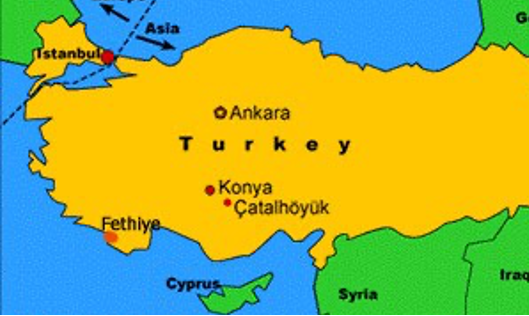Stephanie Guerin-Yodice

Agricultural villages are not civilizations, yet agriculture is necessary for the survival of a civilization. The rise of civilizations developed independently through the ancient world, each with a unique culture linked to its geographical region and the resources provided by nature. Obsidian glass proves to be a transitional element which transformed societies and launched civilizations. Unlike a stone picked up off the ground, obsidian glass comes from a volcano. It provided the small agricultural town of Çatalhöyük with a technological resource that helped humans to establish trade as far west as the Levant and south along the Tigris River and Euphrates River to the Persian Gulf.
In 1959, a team of British archeologists discovered the remains of a Neolithic town (7500 BCE to 5700 BCE) nestled in the Konya plain of Anatolia (present-day Turkey). What they discovered was a very well preserved Neolithic town that represented technology in transition. The people of Çatalhöyük settled in a geographically desirable area that proved to be well protected by forests and included a plateau, plains, waterways, and a stable source of water from the mountains.
Figure 3. Click here: Landscape with Volcano Eruption. Çatalhöyük, Turkey, 6150 BCE. Science News, 2014.
It is assumed that this location developed into an agricultural community that successfully acquired a food surplus, which would then lead to population growth and well-established trade routes.[1] The evidence uncovered by subsequent archeological digs revealed a mix of seminomadic and permanently established communities that used technology to advance their society, thus establishing communities that were rich in culture, resources, and specialized labor. Excavation of the site revealed permanent dwellings, complete with worship centers, shared sleeping quarters, and artifacts that testify to a level of human advancement. Inside one of the dwellings archeologists discovered a painting. After restorative efforts were made, it revealed an image of the town and a volcano in the distance. This discovery helped archeologists to identify the area where obsidian glass was collected and also gave historians insight into how the Çatalhöyük people participated in advanced trade networks. Historians are unclear as to how the people of Çatalhöyük acquired the volcanic glass from Cappadocia, which lay 160 miles northeast of the primitive agricultural settlement, but what is evident is the value this resource provided to the technological advancement of civilizations.[2]
“It has long been argued that this [obsidian] was an extremely valuable resource to Çatalhöyük, not only with regard to its functional capabilities and daily household use, but also in terms of the community’s (alleged) role in its long-distance exchange and its symbolic properties.”[3]
– Stanford University department of Geological and Environmental Science
[1] Andrew Cherratt, “The Obsidian Trade in the Near East, 14,000 to 6500 BC.” ArchAtlas 4.1 (2005). Accessed June 12, 2017. http://www.archatlas.org/ObsidianRoutes/ObsidianRoutes.php
[2]. “Stanford Obsidian Research Team,” Stanford University, https://earthsci.stanford.edu/research/mahood/geoarc_people_sort.htm
[3]. SORT.

